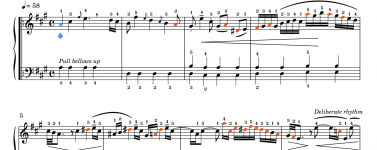bgilesuk
Member
Hello fellow accordionists.
There is a long established convention of placing a small bar or line under the left hand note or finger number, to indicate when the player is to play theses notes on the Counter-bass row, but I can't find a standard convention to indicate when the right hand should play notes in rows 4 or 5.
I know that using right hand rows 4 or 5 is usually left to the discretion of the player, but I like to add fingering to awkward passages and don't want to use my own convention if there is already a well established practice out there.
I seem to remember my teacher putting a circle around the note or the finger number, but can't remember which.
What method do most players use?
Thank you
There is a long established convention of placing a small bar or line under the left hand note or finger number, to indicate when the player is to play theses notes on the Counter-bass row, but I can't find a standard convention to indicate when the right hand should play notes in rows 4 or 5.
I know that using right hand rows 4 or 5 is usually left to the discretion of the player, but I like to add fingering to awkward passages and don't want to use my own convention if there is already a well established practice out there.
I seem to remember my teacher putting a circle around the note or the finger number, but can't remember which.
What method do most players use?
Thank you

